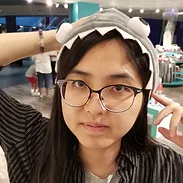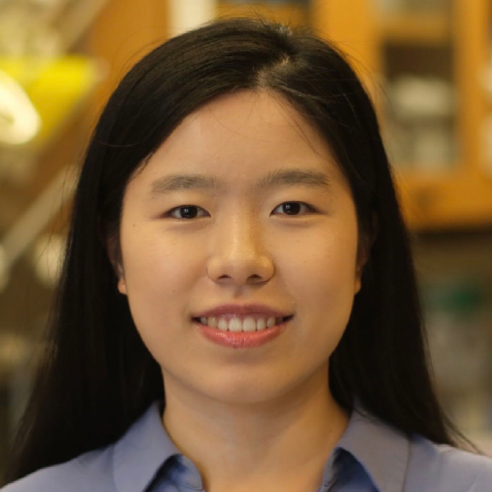
University of California, San Francisco
Appointed in 2007
Read more
University of California, San Francisco
Appointed in 2007


Oxford University, England
Appointed in 1960


Stanford University
Appointed in 1993

University of California, San Francisco
Appointed in 1982
Read more
University of California, San Francisco
Appointed in 1982


Duke University
Appointed in 1996

University of California, Los Angeles
Appointed in 1993
Read more
University of California, Los Angeles
Appointed in 1993

University of Illinois at Urbana-Champaign
Appointed in 2004
Read more
University of Illinois at Urbana-Champaign
Appointed in 2004


Brigham and Women's Hospital
Appointed in 2014
I am interested in how binding of protein modifications contributes to the functions of chromatin complexes. Currently I am developing biochemical and proteomic methods to identify the histone modifications associated with malignant brain tumor (MBT) domain-containing proteins in human tissue culture cells and in fruit flies. The human and fly MBT-containing homologues participate in various aspects of Polycomb group silencing and tumor suppression. Since the MBT domain acts as a methyl lysine-binding module, it is likely that specific modification interactions together with protein interactions enable the localization of otherwise broadly pervasive MBT complexes to specific genomic regions. My graduate training in mass spectrometry complements my postdoctoral training in affinity pulldown of labile interactions with regard to uncovering these potential modification targets.

University of California, Berkeley
Appointed in 2008
Read more
University of California, Berkeley
Appointed in 2008

University of California, Los Angeles
Appointed in 2001
Read more
University of California, Los Angeles
Appointed in 2001

Massachusetts Institute of Technology
Appointed in 1990
Read more
Massachusetts Institute of Technology
Appointed in 1990

Lawrence Berkeley National Laboratory
Appointed in 2004
Read more
Lawrence Berkeley National Laboratory
Appointed in 2004

Stanford University School of Medicine
Appointed in 2005
Read more
Stanford University School of Medicine
Appointed in 2005

University of Illinois at Urbana-Champaign
Appointed in 2013
Read more
University of Illinois at Urbana-Champaign
Appointed in 2013
Resigned due to health reasons


Columbia University
Appointed in 2014
I am studying the function of the mammalian taste system, in particular the molecular identity and diversity of taste-responsive neurons.  The five basic taste qualities -sweet, sour, salty, bitter and umami, are detected on the tongue and palate epithelium by distinct classes of taste receptor cells (TRCs).  The geniculate ganglion is the first neural station between the tongue and the brain; our lab recently showed that ganglion neurons are also tuned to specific taste qualities.  My studies are aimed at understanding how TRC maintain the highly specific transfer of taste information between taste cells and the central nervous system, particularly given that TRCs turn over every few days.  I have optimized a number of approaches to perform single-cell RNA sequencing both in TRCs and ganglion neurons, and am characterizing and classifying taste neurons into distinct classes.  We hope to define molecular markers that will allow us to manipulate the connectivity, function and behavior of TRCs, and the taste system.


New York Genome Center
Appointed in 2020


Rockefeller University
Appointed in 2018
ATP-sensitive potassium channel (KATP) is an ion channel gated by ATP and ADP, and by doing so, it translates the metabolic state of a cell into electric signals. At molecular level, KATP is endowed with sensitivity to ATP and ADP through direct interactions with multiple binding sites. These binding sites are scattered across the entire KATP molecule, which is a tetramer of hetero-dimers that are composed of a type of inward rectifier potassium ion channel (Kir) and an ABC transporter (SUR).Previous studies have identified an inhibitory site on Kir that results in channel closure upon binding to ATP, and stimulatory sites on SUR that favor channel opening when occupied by either MgADP or MgATP. These observations pose a puzzle because in healthy cells ATP exists at millimolar concentrations whereas ADP is present only in the ten micromolar range. How then does KATP detect changes in ADP concentration when the background ATP concentration remains so high that ATP inhibition should dominate? To answer this question, we have to determine what the ATP and ADP affinities are at their respective sites and also understand how occupancy of these sites allosterically regulate the pore’s gate. Once this level of understanding is reached we can then try to predict the response of KATP to different metabolic states. Finally, we can integrate these responses into the broader signaling network that involves other closely related partners to describe the action of KATP at a systems biology level. My project in the MacKinnon lab aims to address this problem using a combination of electrophysiology and structural biology techniques.


Gladstone Institute
Appointed in 2024
The first century of molecular biology discoveries was enabled by the study of Nature’s original molecular biologists: viruses. Viruses and their simpler cousins, sub-viral RNAs are extremely well adapted to manipulate their host cell. By studying how these agents alter their host, scientists have been able to both understand the mechanisms of diseases as well as derive tools to fight them. Yet there is still much we don’t know about viruses, but even less-so about sub-viral RNAs. Obelisk RNAs are a recently discovered class of widespread sub-viral RNAs with small, structured genomes that seem to bear no resemblance to any known biological entity. The study of Obelisk biology then might reveal molecular mechanisms that have yet to be seen.
Dr. Ivan Zheludev will characterize a novel class of sub-viral RNAs, termed Obelisk RNAs, in Dr. Melanie Ott’s lab at the Gladstone Institute of Virology using a model Obelisk-host system based on a human oral bacterium. Using this system, Zheludev will probe how Obelisk RNA replicates and spreads between cells, the function of the Obelisk-encoded protein Oblin-1, and how Obelisk RNA impacts the host bacterium within complex microbial communities such as the human oral microbiome. Zheludev’s studies will provide foundational knowledge for understanding Obelisk RNAs and provide a general framework for investigating sub-viral RNAs.
Zheludev’s interest in sub-viral RNAs stems from his Ph.D. research in Dr. Andrew Fire’s lab at Stanford University. There, Zheludev created a bioinformatic discovery tool and used it to discover a new class of sub-viral RNAs that he named “Obelisk” RNAs. He demonstrated that Obelisk RNAs are widespread, with examples found on every continent, and that they are diverse, having identified roughly 30,000 distinct Obelisks. Further, they are also found in the microbiomes of between five to fifty percent of assayed human donors. Now in his postdoctoral research, Zheludev will investigate Obelisk molecular biology and their host interactions.

Stanford University School of Medicine
Appointed in 1998
Read more
Stanford University School of Medicine
Appointed in 1998


Boston Children's Hospital
Appointed in 2022

Massachusetts Institute of Technology
Appointed in 1993
Read more
Massachusetts Institute of Technology
Appointed in 1993


Yale University School of Medicine
Appointed in 2014
Many human diseases are associated with aberrant inflammation. While the inflammatory response functions to protect an organism against harmful pathogens or to restore tissue homeostasis, excessive inflammation is known to alter tissue functions and damage host tissues. This phenomenon is termed immunopathology and is a major contributor to human morbidity. Therefore, limiting immunopathology is critical in many pathological scenarios. There are two potential means to control immunopathology: to act on immune cells to directly suppress the generation of inflammatory response (“anti-inflammatory” mechanisms), or to act on target tissues to reduce or reverse the deleterious effects caused by inflammation (“counter-inflammatory” mechanisms). A body of previous works has contributed to our knowledge of the anti-inflammatory mechanisms, but the counter-inflammatory mechanisms remain largely elusive. Currently, I am using cellular responses to inflammatory cytokines as the experimental system to identify the counter-inflammatory signals. Meanwhile, I am characterizing their potential mechanisms by taking advantage of the computational and systematic approaches.


University of California, Berkeley
Appointed in 2018
Our genomes are packaged into functional units of DNA called chromosomes, which are constantly being re-organized and re-shaped to match the demands of the cell. The most dramatic form of this reorganization happens as the cell prepares to divide: chromosomes are replicated, highly condensed, and aligned at center of the mitotic spindle, the complex protein-based machinery that physically separates exactly one copy of the genome to each daughter cell. Errors in this complex sequence of events can result in broken or rearranged chromosomes, known to be a significant source of mutations that drive the progression of many cancer types. A key factor in maintaining genome integrity during cell division is careful regulation of the length of the mitotic chromosome. In studies where chromosomes are artificially lengthened, the mitotic spindle fails at pulling the chromosomes apart, especially when certain cell cycle regulators are depleted. These results suggest that there are molecular pathways that can sense the physical dimensions of a chromosome and communicate this property to downstream regulators of the mitotic machinery. Yet, the exact dimensions being sensed and the molecules involved in this relay of information are still a mystery. Our goal is to identify the molecular pathways that sense, shape and re-enforce chromosome size during cell division. To do this, we will use the vertebrate model system Xenopus laevis, a powerful system for studying how physical dimensions of subcellular structures are determined during embryo development. Previous work from our lab has shown that mitotic chromosomes isolated from embryos in later stages of development are shorter compared to those isolated from early development. These results have provided a launching pad for our proposed work to now identify the molecular pathways that govern this change in size. We aim to (1) characterize how chromosomes are re-organized as they shrink, (2) find the molecules that contribute to these observed size changes and (3) implement the latest advances in imaging technology to test how changes in chromosome size affect embryo development. Because large-scale chromosome rearrangements are a driving force for many cancers, our findings will also provide a foundation for further research into how cancer cells hijack normal chromosome-size control pathways to continue growing and dividing. Also, since cellular behaviors during embryo development are very similar to those in a growing tumor, the tools we will develop to image chromosome dimensions in a growing embryo will greatly enhance our ability to visually assess large-scale chromosome rearrangements in cancer cells, both for research and diagnostics purposes.


Harvard University
Appointed in 2014
I am using structural techniques to study pain transduction by transient receptor potential (TRP) ion channels. TRPs comprise a large family of pain sensors activated by diverse stimuli from noxious temperatures to small molecules. My work focuses on understanding the regulation of ion channel opening by such stimuli at the atomic level.
My interest in biochemistry was piqued after taking organic chemistry as an undergraduate at UC Berkeley. I followed my interest in molecular detail to graduate school where I discovered my love for protein structure. During my PhD work at MIT, my studies of the enzyme ribonucleotide reductase led to a thesis focused entirely on allosteric regulation. Since then, I have been intrigued by how proteins use allostery to perform remarkable structural transformations that affect function. TRP channels are master integrators of allosteric signals. They are an ideal system for studying complex allostery and an atomic level understanding of TRP channel activation will provide a foundation for understanding pain.

University of California, San Francisco
Appointed in 2016
Read more
University of California, San Francisco
Appointed in 2016
Transcription circuits, defined as transcription regulators and the DNA cis-regulatory sequences they bind, control the expression of genes and define cellular identity. In eukaryotic cells, regulatory networks tend to be large, containing many highly interconnected transcription factors. Many of these complex networks are bistable, meaning they can toggle between two stable steady states. Bistable networks are responsible for such varied processes such as irreversible decisions during cell cycle progression, embryonic stem cell differentiation and oocyte maturation._x000D_
_x000D_
I study a bistable transcriptional network in the human commensal yeast Candida albicans that controls an epigenetic switch between two distinct cell types. This network shows many features of those in higher eukaryotes including the high degree of stability of each cell type. The goal of my research is to gain a molecular understanding of the functional differences between the multiple feedback loops present in bistable transcriptional circuits. This analysis will serve as a model for the general understanding of complex circuits.

Whitehead Institute for Biomedical Research
Appointed in 2009
Read more
Whitehead Institute for Biomedical Research
Appointed in 2009
I am studying the molecular mechanisms by which nutrients activate the mTOR kinase, a central regulator of the growth of cells and organisms.
I am a native of Italy, where I earned a BSc in biological sciences from the University of Pisa. I entered the PhD program at Yale to study how membranes are trafficked to and from the surface of the cell, and how these mechanisms contribute to the function of synapses and to neuronal transmission. To this end, I applied advanced live microscopy techniques such as total internal reflection (TIR).  During my PhD work, I became interested in the role of cellular membranes in propagating signals that originate at the cell surface, and how these processes become aberrant in cancer.  To pursue this direction I joined the laboratory of David Sabatini at the Whitehead Institute in 2008. Here, I am combining biochemical techniques with advanced microscopy to investigate how the lysosome, an organelle involved in the degradation and recycling of cellular components, participates in the activation of mTOR complex 1 (mTORC1). In my free time I enjoy running, martial arts, sailing on the Charles River and playing bass in a rock band.


Harvard University Medical School
Appointed in 1998


Harvard University
Appointed in 2010
I am using mouse embryonic stems cells to understand the sources of cell-to-cell variation during early development, and examining what these variations can tell us about mechanisms regulating early development.
I was first attracted to science by learning that the amazing diversity of life arose from the operation of a simple abstract principle ¬ó natural selection. At university, I turned towards physics, studying how diverse macroscopic physical phenomena (e.g. elasticity and electrodynamics), arising from distinct microscopic laws, can be described on the basis of similar abstract physical concepts. That idea, and the fact that we can extract basic properties of a physical system from apparently random fluctuations, guided my doctoral research.
My current research asks whether these ideas from physics can be useful to the study of biological processes. Consider the variable responses of cells in a culture dish when exposed to the same stimulus. Can we extract information about how cells make decisions by a careful analysis of this variability? Although the simplest cells are far more complex than any physical material, such questions are worth asking. Even if we cannot answer them, the inquiring may point towards some essential characteristics of biological processes.


The University of Chicago
Appointed in 2024
Translation is a key step in gene regulation that dynamically responds to cell stress, signaling, and metabolic alterations. While there are techniques that allow for investigating transcription with single-cell resolution, similar tools for examining translation are lacking.
Dr. Zhuoning Zou will develop a method for analyzing translation in single cells from complex samples in Dr. Chuan He’s lab at the University of Chicago. Dr. Zou’s method will use in situ reverse transcription to develop a spatially resolved single-cell translatome profiling method. This method will enable measuring differences in translation between distinct types of cells in a heterogeneous mixture. For example, Zou will apply her method to patient biopsies and surgical colon cancer samples. In such samples this method will distinguish translation between different individual cancer cells as well other types of cells in the tumor microenvironment. This research will uncover the translation landscape in real human tissues, provide novel insights into translation regulation in the tumor microenvironment, and may reveal potential biomarkers for cancer prognosis and targets for future therapies.
Zou developed sensitive methods for monitoring translation and applied them to rare and heterogenous samples in Dr. Wei Xie’s lab at Tsinghua University. During her graduate studies she helped pilot a method that investigates translation of a single mouse oocyte. Zou then applied that method to human oocytes and early embryos to reveal novel and dynamic translational regulation in early embryogenesis. Now Zou will apply her expertise to examine translational regulation in cancer cells and other cells in the surrounding tumor microenvironment during her postdoctoral research.

Johns Hopkins University School of Medicine
Appointed in 2014
Read more
Johns Hopkins University School of Medicine
Appointed in 2014

University of California, Berkeley
Appointed in 1984
Read more
University of California, Berkeley
Appointed in 1984

National Institutes of Health
Appointed in 1990
Read more
National Institutes of Health
Appointed in 1990